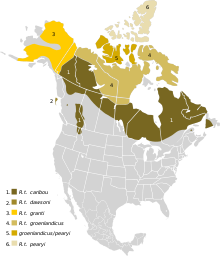Porcupine caribou
| Porcupine caribou | |
|---|---|
 |
|
| Male Porcupine R. t. granti grazing in Alaska | |
| Scientific classification | |
| Kingdom: | Animalia |
| Phylum: | Chordata |
| Class: | Mammalia |
| Order: | Artiodactyla |
| Family: | Cervidae |
| Subfamily: | Capreolinae |
| Genus: | Rangifer |
| Species: | R. tarandus |
| Subspecies: | R. t. granti |
| Trinomial name | |
|
Rangifer tarandus granti Allen, 1902 |
|
 |
|
| Approximate range of Porcupine caribou in yellow. Overlap with other subspecies of caribou is possible for contiguous range. 1. Woodland caribou (R. t. caribou) subdivided into ecotypes: boreal, migratory, montane, 2. R. t. dawsoni extinct 1907, 3. Porcupine caribou R. t. granti, 4. Barren-ground caribou R. t. groenlandicus, 5. groenlandicus/pearyi, 6. Peary caribou R. t. pearyi | |
The porcupine caribou or Grant's caribou (Rangifer tarandus granti) is a subspecies of the caribou found in Alaska, United States, and adjacent parts of Canada. It resembles the subspecies, barren-ground caribou (R. t. groenlandicus), and is sometimes included in it.
Migratory caribou herds are named after their birthing grounds, in this case the Porcupine River, which runs through a large part of the range of the Porcupine herd. Though numbers fluctuate, the herd comprises approximately 169,000 animals (based on a July 2010 photocensus). They migrate over 1,500 mi (2,400 km) a year between their winter range and calving grounds at the Beaufort Sea, the longest land-migration route of any land mammal on earth. Their range spans the Alaska/Yukon border and is a valued resource cooperatively managed by the Alaska Department of Fish and Game, Canadian wildlife agencies, and local aboriginal peoples. The caribou are the primary sustenance of the Gwichʼin, a First Nations/Alaska Native people, who traditionally built their communities to align with the caribou's migration patterns. They are also routinely hunted by other indigenous peoples, including the Inupiat, Inuvialuit, Hän, and Northern Tutchone.
Unlike many other Rangifer tarandus subspecies and their ecotypes, the Porcupine herd is stable at relatively high numbers, but the 2013 photo-census was not counted by January 2014. The peak population in 1989 of 178,000 animals was followed by a decline by 2001 to 123,000. However by 2010, there was a recovery and an increase to 169,000 animals.
There has been a controversy over disturbance of the Porcupine caribou herd by allowing oil exploration, drilling and development in the Arctic National Wildlife Refuge since 1977. The controversy focused on a 1,500,000 acres (6,100 km2) subsection on the coastal plain, known as the "1002 area". Of particular concern is the effect on the calving ground of the Porcupine caribou.
...
Wikipedia
